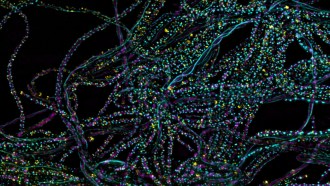
Climate
Capturing methane from the air would slow global warming. Can it be done?
Removing methane from the atmosphere requires different technology from removing carbon dioxide. Scientists are taking on the challenge.
Every print subscription comes with full digital access

Removing methane from the atmosphere requires different technology from removing carbon dioxide. Scientists are taking on the challenge.

The Athel tamarisk excretes excess salt through its leaves. The buildup of salt crystals pulls water directly from the air, a study reports.

Moungi Bawendi, Louis Brus and Alexei Ekimov split the prize for their work in creating nanoparticles whose properties depend on their size.

In the 1970s, scientists were on the hunt for superheavy elements. They’ve since found more than a dozen and are searching for more.

Researchers developed a process to turn plastic waste into surfactants, the key ingredients in dozens of products, including soap.

Iron oxide particles adorned with “sticky” molecules trap estrogen in water, possibly limiting the hormone’s harmful effects on aquatic life.

Researchers are confirming some of the techniques that Benjamin Franklin and his associates used to help early American paper currency succeed.

Adding easy-to-break molecular connectors surprisingly makes materials harder to tear and could one day reduce microplastic pollution from car tires.

Molecular fossils suggest the existence of a lost world of primitive eukaryotes that dominated aquatic ecosystems from at least 1.6 billion to 0.8 billion years ago.

A single particle of light is the spark that begins the process of turning light to chemical energy in photosynthetic bacteria, a new study confirms.
Subscribers, enter your e-mail address for full access to the Science News archives and digital editions.
Not a subscriber?
Become one now.